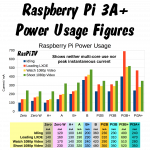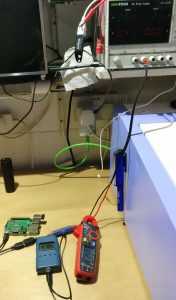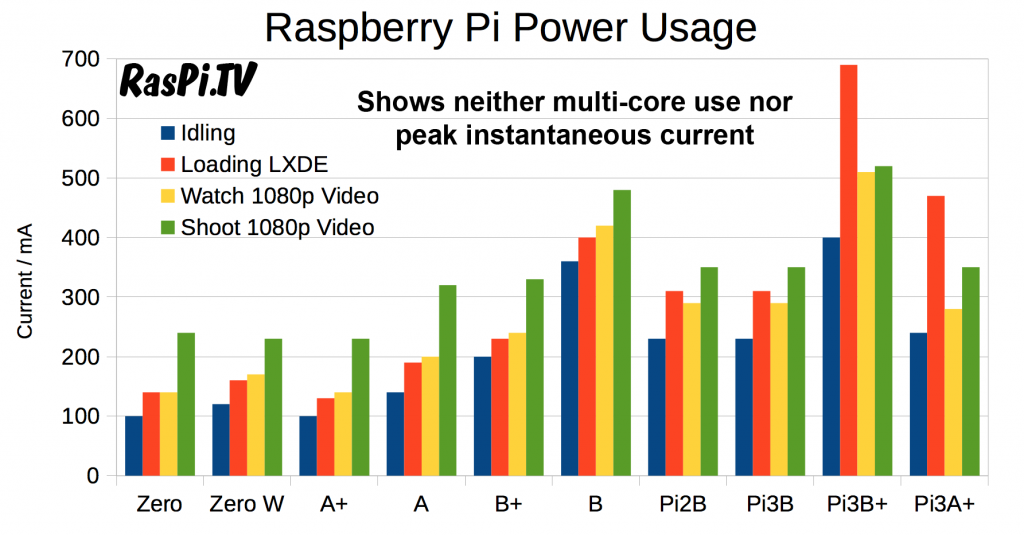
When a new Pi comes out, I usually publish some power consumption figures, mainly for those people who want to estimate battery durations. So my tests are quite simple.

eMeter, clamp meter and bench PSU all being used to check power consumption of Raspberry Pi (3B plus in the photo)
Procedure
With just an HDMI screen and a USB keyboard/mouse dongle connected, the Pi is powered using a bench power supply at 5.2V (supply current limit = 3 Amps) wired, via my eMeter’s calibrated 20 Amp shunt, to the µUSB power input on the Pi.
Current and voltage are measured using the eMeter (with clamp meter to confirm) and calibrated shunt whilst performing four different activities on the latest Raspbian distro…
- Idling
- Loading LXDE (
startx) - Watching a 1080p video on the µSD card with omxplayer
- Shooting 1080p video with a Pi camera 1 (but not recording to µSD card)
The camera module is unplugged for all but the shooting video test. The Pi3A+ was connected to wifi, but no bluetooth devices were in use.
Understanding the Limitations
It’s important to understand the limitations of any equipment, tests and results. Comparing the readouts on the bench power supply, clamp meter and taking the actual data readings from the eMeter gives a reasonable degree of confidence in the results (when they agree, which they did fairly well).
The eMeter gives time-averaged readings (updated several times per second) to two decimal places of an Amp, which is good enough for our purposes. It won’t give a true picture of peak instantaneous current e.g. on power-up of the ARM cores from idle. This matters only when selecting a PSU to run your Pi (you already have the official recommendations of a 2.5 Amp PSU for that). What we’re interested in is power usage over time, so you can work out what size battery pack or solar panel you will need for portable applications.
Results
Commentary
The Pi3A+ has the same power circuitry, wifi module & BCM2837B0 quad-core A54 (ARMv8) 64-bit @ 1.4GHz as the Pi3B+. The main differences between 3B+ and 3A+ are that the 3A+ has…
- no ethernet/USB hub chip
- half the RAM (512MB vs 1GB)
- a single USB port
- the A+ form factor
Therefore, I’d expect it to consume a bit less power than the Pi3B+, mainly due to the lack of ethernet/USB hub chip. But because it has the newer, faster, quad-core BCM2837B0 silicon of the Pi3B+ I’d expect it to be more power-hungry than the original Pi1A+ model which has BCM2835.
In fact that’s exactly how it turns out. The Pi3A+ is…
- about twice as power-hungry as the Pi1A+ at idle (240 mA vs 100 mA), and 3.6 times as power-hungry when the CPU is working hard loading LXDE (470 mA vs 130 mA)
- about 200 ± 20 mA less power-hungry than the Pi3B+ (350 mA vs 520 mA at idle and 470 mA vs 690 mA loading LXDE)
N.B. These simple tests do not consider multi-core CPU operation.
It should be noted that although the 3A+ chews through a lot more power loading LXDE, it does the work much more quickly, so it doesn’t automatically mean that the overall process uses more power. To judge this accurately would require timing the loading sequences on both devices and recording the total number of mAh used.
The 200 ± 20 mA difference is mostly the result of removing the ethernet/hub chip. So there are no big surprises in these results. They are pretty much what we would expect, given the changes made to the board.


Neat. Thanks Alex :-)
Will you also be doing an updated “family photo”, just in time for Xmas?
I have it in mind to do one fairly soon, yes :)
The main issue is that the way I take the shots requires a bit of early afternoon sunshine (or the shadow will be wrong), so no luck today.
Sunshine…? What’s that?! ;-D
Precisely. I think we had a period of sunshine this morning, but it must have been while I was blinking.
Thanks, This is the sort of information I like but am too lazy to compile myself. ;-)